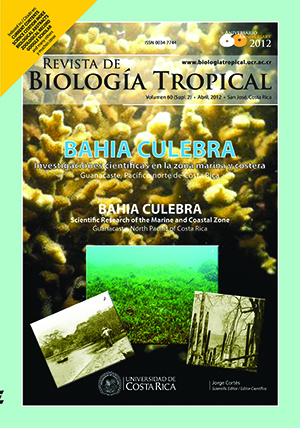Abstract
Mangrove forests are abundant and important coastal marine ecosystems that are being impacted by human activity in Costa Rica. There are two mangrove stands (Panamá and Iguanita) in Bahía Culebra, Guanacaste, North Pacific coast of Costa Rica. Their forest structure was determined with the Point-Centered Quarter Method (PCQM) during the dry season (December 2007-March 2008). Eleven transects were established at Panamá mangrove, with a total of 52 points and 208 quadrats. Two transects were established at Iguanita with a total of 16 points and 62 quadrats given access difficulty. Mapping of both stands was done with two georeferenced MASTER CARTA 2005 images. Images were digitized to 1:5000 scale using the following categories: mangrove forest, low density mangrove, no mangrove, transition to dry forest, sand and water. In the area studied at Panamá was 13.7ha, and 40.8ha for Iguanita. Panamá is mostly composed of dense mangrove forest (51% of total study area) and dry forest species (35% of total study area). A small area (2%) had dry soil and scarce mangrove trees and the remaining 12% corresponds to water, sand and other areas without vegetation. At Iguanita, 84% was dense mangrove, 5% scarce mangrove trees and the remaining 10% corresponds to water, sand and other areas without vegetation. Five mangrove species were encountered at Panamá (Avicennia germinans, Avicennia bicolor, Conocarpus erectus, Laguncularia racemosa, and Rhizophora mangle), and three at Iguanita (A. germinans, L. racemosa, and R. mangle). Species zonation was similar at both stands; with Rhizophora near water channels and inundated areas, Avicennia frequent in drier areas, and Laguncularia (both stands) and Conocarpus (only Panamá) more frequent near fresh water input. Densities at both stands (Iguanita= 67.2 and Panamá= 8.4 stems/0.1 ha) were lower than reported for the north Pacific of Costa Rica. Complexity index was higher at Iguanita (CI= 86.5) with R. mangle dominance, than Panamá (CI= 1.1) with A. germinans dominance. While both stands are in Bahía Culebra, structurally they are very different and seem to be under two different hydrodynamic contexts. Sea level rise related to global climate change might impact both mangrove stands as they would not be able to migrate further inland (given land elevation at the back of Iguanita, and a paved road at Panamá). Given the socio-economic and ecological importance of mangrove habitats, further study and continued conservation efforts of Costa Rican mangroves are needed.Comments
Downloads
Download data is not yet available.






